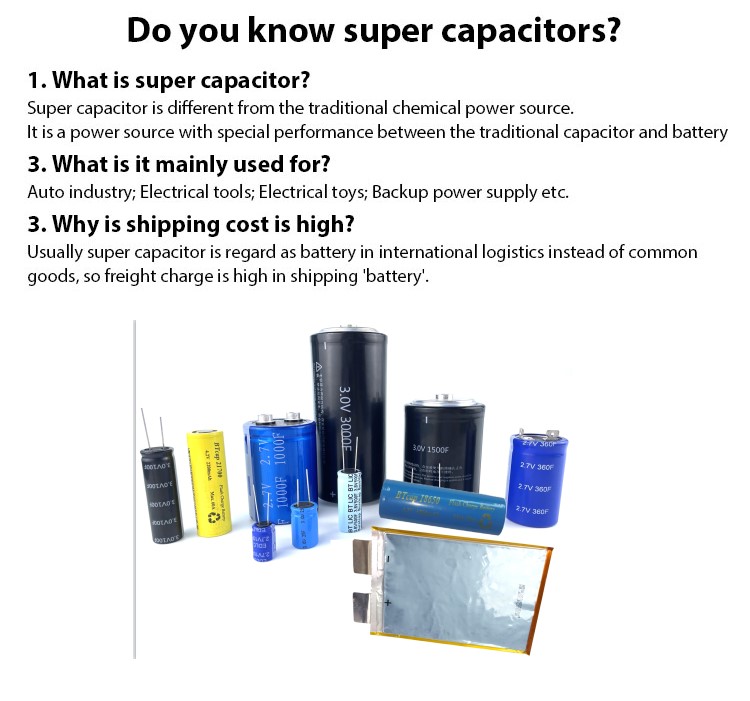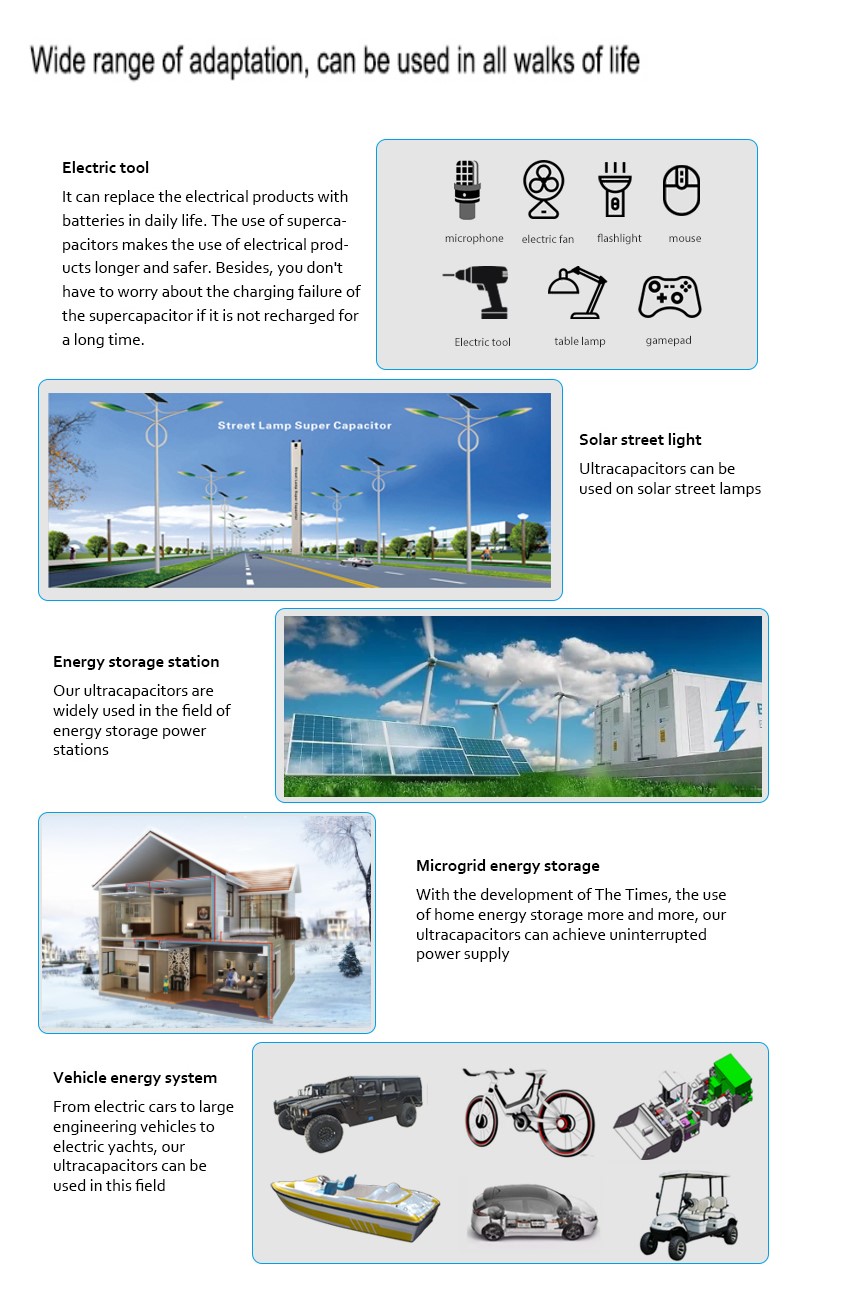Consulting phone:
135-3037-2041
(Mr.Wang)
Product Introduction:
Double layer capacitors, also known as supercapacitors, are a new type of energy storage device with high energy density electrochemical capacitors, which are several thousand times higher than ordinary electrolytic capacitors. Double layer capacitors have the characteristics of short charging time, long service life, good temperature characteristics, and energy conservation and environmental protection.
Series specification table:
specifications | characteristic | |||||||
Rated voltage VR | 3.0V.DC | |||||||
Surge voltage | 3.15V.DC | |||||||
Capacity range | 1-120F | |||||||
Operating temperature range | -40℃~+65℃ | |||||||
Product lifespan | Normal temperature cycle life: Charge and discharge the capacitor 1 million times between the specified voltage and half rated voltage using a constant current at 25 ℃. Capacity attenuation ≤ 30% times, internal resistance variation ≤ 3 times | |||||||
High temperature durability life: Apply rated voltage for 1000 hours under+65 ℃ conditions. Capacity attenuation by 30%, internal resistance variation ≤ 3 times | ||||||||
Product Performance Table:
Product model | Rated voltage (V) | Nominal capacity (F) | Product ruler Inch mm | internal resistance | Working current (A) ∆ T=15 ℃ | Peak current (A) | leakage current (72 hours/µ A) | High energy (W.h) | Energy density (W.h/kg) | Functional density (kw/kg) | |
Outer diameter( ϕ D) | Height (L) | ESRA C(mΩ/1KHz) | |||||||||
YKY3R0S105C01DSZ | 3.0 | 1 | 6.3 | 12 | 250 | 0.18 | 0.68 | 3 | 0.0013 | 1.67 | 1.20 |
YKY3R0S105C02DSZ | 3.0 | 1 | 8 | 12 | 180 | 0.26 | 0.83 | 5 | 0.0013 | 1.37 | 1.48 |
YKY3R0S205C02DSZ | 3.0 | 2 | 8 | 12 | 130 | 0.26 | 1.15 | 6 | 0.0025 | 2.75 | 1.48 |
YKY3R0S205C03DSZ | 3.0 | 2 | 8 | 16 | 120 | 0.43 | 1.74 | 8 | 0.0025 | 2.27 | 2.73 |
YKY3R0S335C04DSZ | 3.0 | 3.3 | 8 | 20 | 95 | 0.53 | 2.53 | 10 | 0.0041 | 2.84 | 2.57 |
YKY3R0S505C04DSZ | 3.0 | 5 | 8 | 20 | 80 | 0.59 | 3.41 | 12 | 0.0063 | 4.17 | 3.00 |
YKY3R0S505C06DSZ | 3.0 | 5 | 10 | 20 | 70 | 0.77 | 3.93 | 15 | 0.0063 | 2.84 | 2.73 |
YKY3R0V705C05DSZ | 3.0 | 7 | 8 | 25 | 80 | 0.71 | 4.38 | 18 | 0.0088 | 4.61 | 2.84 |
YKY3R0V705C06DSZ | 3.0 | 7 | 10 | 20 | 60 | 0.81 | 4.95 | 18 | 0.0088 | 3.65 | 2.81 |
YKY3R0V106C06DSZ | 3.0 | 10 | 10 | 20 | 50 | 0.94 | 6.82 | 18 | 0.0125 | 5.1 | 3.67 |
YKY3R0V106C07DSZ | 3.0 | 10 | 10 | 25 | 40 | 1.27 | 8.33 | 20 | 0.0125 | 4.46 | 2.84 |
YKY3R0V106C09DSZ | 3.0 | 10 | 12.5 | 20 | 40 | 1.35 | 8.57 | 25 | 0.0125 | 3.57 | 4.11 |
YKY3R0V156C09DSZ | 3.0 | 15 | 12.5 | 20 | 40 | 1.35 | 10.59 | 30 | 0.0188 | 5.07 | 3.89 |
YKY3R0V156C10DSZ | 3.0 | 15 | 12.5 | 25 | 35 | 1.54 | 10.98 | 35 | 0.0188 | 4.36 | 3.59 |
YKY3R0V206C10DSZ | 3.0 | 20 | 12.5 | 25 | 35 | 1.66 | 13.64 | 50 | 0.0250 | 5.43 | 3.91 |
YKY3R0V256C12DSZ | 3.0 | 25 | 16 | 20 | 25 | 1.9 | 16.67 | 70 | 0.0313 | 5.21 | 3.60 |
YKY3R0V306C14DSZ | 3.0 | 30 | 16 | 30 | 20 | 2.53 | 20.45 | 80 | 0.0375 | 4.46 | 3.21 |
YKY3R0V506C15DSZ | 3.0 | 50 | 18 | 40 | 15 | 4.34 | 37.5 | 100 | 0.0625 | 4.7 | 4.06 |
YKY3R0V107C16DSZ | 3.0 | 100 | 18 | 60 | 12 | 5.85 | 57.69 | 260 | 0.1250 | 5.95 | 3.21 |
YKY3R0V107C17DSZ | 3.0 | 120 | 18 | 60 | 12 | 5.85 | 61.64 | 260 | 0.1500 | 7.14 | 3.21 |
Dimensional diagram (unit: mm)
Product Display:




Our products are complete:

Application field:

Testing method:
1. Electrostatic capacity testing method:
(1) Testing Principles
The testing of electrostatic capacity of supercapacitors is carried out by using the method of constant current discharge of capacitors and calculating them according to a logical formula. C=It (U1-U2), where: C - electrostatic capacity, F; I - Constant discharge current, A; U1, U2- using voltage, V; Discharge time required from t-U1 to U2, S
(2) Test program
Charge the capacitor with a current of 100A until it reaches the working voltage and remains constant for 10 seconds. Then discharge the capacitor with a current of 100A, taking U1 as 1.2V and U2 as 1.0V. Record the discharge time within this voltage range, the total electrostatic capacity of the cycles, and take the average value.
2. Energy storage test
(1) Testing principle:
The testing of supercapacitor energy is carried out by discharging the capacitor at a constant power to 1/2 of the working voltage within the voltage range given by the capacitor. The output energy W of a capacitor is obtained from the relationship between a constant discharge power P and a discharge time T, that is, W=P T
(2) Testing process
Charge the capacitor to the working voltage with a constant current of 100A, then keep it constant until the charging current drops to the specified current (traction type 10A, starting type 1A). After standing still for 5 seconds, discharge the capacitor to 1/2 of the working voltage with a constant power, record the discharge time, and calculate the value. Cycle 3 measurements and take the average value.
3. Equivalent series resistance test (DC)
(1) Testing Principles
The internal resistance of a capacitor is measured based on the sudden change in voltage within 10 milliseconds after the capacitor is disconnected from the constant current charging circuit. In the formula, R - the internal resistance of the capacitor; U0- The voltage before the capacitor is cut off for charging; Ui - Cut off the voltage within 10 milliseconds after charging; I - Cut off the current before charging.
(2) Measurement process
Charge the capacitor with a constant current of 100A, disconnect the charging circuit at 80% of the working voltage, use a sampling machine to record the voltage change within 10 milliseconds after the capacitor is powered off, and calculate the internal resistance. Repeat three times and take the average value.
4. Leakage current test
Charge the capacitor at a constant current of 100A to the rated voltage, charge it at this voltage for 30 minutes, and then open the circuit and let it stand for 72 hours. Record the voltage value every minute for the first three hours, and every ten minutes for the remaining time.
Calculate the self discharge energy loss, SDLF=1- (V/VW) 2, and the calculation time points are: 0.5,1,8,24,36,72 hours
Note: The voltage tester must have a high input impedance to minimize the sound of the discharge.
Instructions for use:
1. Supercapacitors have fixed polarity. Polarity should be confirmed before use.
2. Should be used at nominal voltage. When the voltage of the capacitor exceeds the nominal voltage, it will cause electrolyte decomposition, and the capacitor will heat up, reduce capacity, increase internal resistance, shorten lifespan. In some cases, it can lead to the performance collapse of the capacitor.
3. Not applicable to circuits with high-frequency charging and discharging. High frequency rapid charging and discharging can cause internal heating, capacity degradation, and increased internal resistance in capacitors, which in some cases can lead to performance degradation.
4. The external environmental temperature has a significant impact on the service life. Capacitors should be kept as far away from heat sources as possible.
5. The voltage drop when used as a backup power source. Due to the high internal resistance of supercapacitors, there is a voltage drop at the moment of discharge Δ V=IR.
6. Do not be in a place with a relative humidity greater than 85% or containing toxic gases. These environments can cause corrosion of the leads and capacitor housing, leading to open circuits.
7. Cannot be placed in high temperature and humidity environments. It should be stored in an environment with a temperature of -30+50 ℃ and a relative humidity of less than 60% to avoid sudden temperature rise and drop, otherwise it may cause damage.
8. When used on double-sided circuit boards, the connection should not pass through areas that can be reached by capacitors. Due to the installation method of supercapacitors, short circuits may occur.
9. When soldering capacitors onto the circuit board, do not allow the capacitor housing to come into contact with the circuit board. Otherwise, the solder will seep into the wire holes of the capacitor, affecting its performance.
10. After installing the supercapacitor, do not forcefully tilt or twist the capacitor. Otherwise, it will cause the capacitor leads to become loose, leading to performance degradation.
11. Avoid overheating the capacitor during the welding process. If the capacitor overheats during welding, it will reduce the service life of the capacitor. For example, if a printed circuit board with a thickness of 1.6mm is used, the welding process should be at 260 ℃ and the time should not exceed 5 seconds.
12. After the capacitor is welded, the circuit board and capacitor need to be cleaned. Because certain impurities may cause a short circuit in the capacitor.
13. Connect capacitors in series for use. Due to process reasons, the rated working voltage of single pole supercapacitors is generally around 2.8V, so they must be used in series in most cases. As it is difficult to ensure that the capacity of each individual in the series circuit is 100% the same, and it is also difficult to ensure that the leakage current of each individual is the same. This can lead to different charging voltages for each individual in the series circuit, which may cause overvoltage damage to the capacitor. Therefore, a voltage equalization circuit must be added to the series connection of supercapacitors. When supercapacitors are used in series, there is a problem of voltage balance between individual cells. Simply connecting in series can cause overvoltage in one or several individual cells, thereby damaging these capacitors and affecting their overall performance. Therefore, when using capacitors in series, technical support from the manufacturer is required.